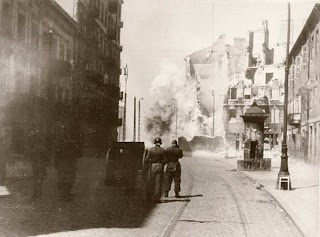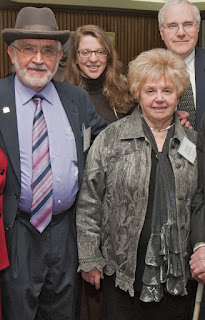
In 1941, the Germans occupied Greece, dividing the country among the Fascist Italians and Bulgarians and establishing a Greek collaborationist government to control the important regions of Athens and Thessaloniki (or
Saloniki). This is where David Broudo was born in 1924. Descendants of the Sephardic Jews were exiled from Spain in 1492, and some made their way to Greece. The Broudo family had lived in Saloniki since the days of the Ottoman Empire.
Greece's involvement in WWII began in October of 1940 when Mussolini ordered an Italian invasion through Albania. The Greek army not only managed to successfully repel the attack, they also drove the Italians back, occupied a quarter of Albania, and subdued 530,000 Italian troops. Although this was the first victory for Allied forces in WWII, the Germans immediately closed in on Greece through Bulgaria and Yugoslavia, bringing an end to the Greco-Italian War and beginning the Nazi occupation of Greece. Over the next year and a half, the Jewish Greek population became increasingly marginalized, and in 1943, the entire Broudo family was deported.

Unlike other members of his family, who were sent directly to Germany, David was sent to a holding camp near Lamia, Greece. With one desperate and courageous attempt, David leapt onto the roof of a passing train, escaping the grasp of the Nazis.
David made his way to the forest where he came across a brigade of Greek
andartes, the Greek guerrilla fighters who first appeared in the mountains of Macedonia in 1941. Once Broudo revealed his identity, he learned that the resistance group contained other Jewish members. For the next year, David fought as a guerrilla resistance fighter with the
andartes, participating in the pitched gun battles of Crete and Lamia, during which many of his comrades fell to German bullets.
David Broudo (far right) with the Greek partisans, 1943
He helped destroy the supply lines the Germans had established for their campaign in North Africa by blowing up bridges and trains, sabotaging the train tracks. Most ingeniously, he smuggled munitions supplies destined for the resistance movement in Athens, past the German blockades, by emptying milk barrels and filling them with guns. His fighting prowess earned him an officer’s commission with the Greek resistance. By the time of the liberation he was planning and executing sabotage missions, as well as interrogating high-ranking German prisoners.

In 1944, Broudo and almost 50,000 other Greeks were imprisoned for their war efforts. From the prison, David was sent with forty-five other men to a desolate Greek island where he spent three and a half years, afterwards being transferred to prisons in Agrinio, Corfu, Oiru, Lamia, Zakynthos, and Evia. Of the experience Broudo said:
“This was a Greek island that was empty of human beings, only the wind. Not one person was on this island. The sea winds moved and nothing else. No one lived there. They would come and bring water and speak with ships once a week if they could enter. The water on the island was saltwater. Once, they didn't show up for a month. Airplanes flew over and dumped water and that was it.”
After the liberation, David's partisan efforts continued. As he described in a JPEF interview:
“After liberation, we went there and waged war against the English, against those who sat in Cairo. But in Cairo, half of them were Communists. Those people in Cairo who escaped Greece when the Germans invaded included officers, half of whom were Communists. The English were put into jails in Cairo. Afterwards, they were brought to Greece, and they were with the king and tanks. For the first time, I saw these tanks that Churchill brought with him, him being in Libertania in a hotel.”
When the war ended, David was sentenced to death by Greek authorities. His sentence was later commuted to life in prison and in 1956 he was deported to Israel where he lived until his death on January 16, 2011. Several decades after the war, the Greek government recognized David Broudo and the efforts of the partisan fighters.
David Broudo and other partisans, date unknown.
Broudo wrote an article entitled “Saloniki Memories,” about his experience in the war, and collaborated with another Jewish
andarte on a book about the history of the Saloniki Jews.
Watch JPEF's
interviews with David Broudo.





























 On October 7th,1944, at a line-up around three in the afternoon, a revolt in the Auschwitz concentration camp began with the swing of a hammer and a shout of “Hurrah!” from Chaim Neuhof, who had been a Sonderkommando – one of the prisoners selected to work in the gas chambers and crematoria – since 1942. The remaining Sonderkommando followed and assisted Neuhof in attacking the SS guards with hammers and axes that were smuggled in with the help of local partisans. An especially sadistic SS guard was thrown into the ovens after being stabbed - but still alive.
On October 7th,1944, at a line-up around three in the afternoon, a revolt in the Auschwitz concentration camp began with the swing of a hammer and a shout of “Hurrah!” from Chaim Neuhof, who had been a Sonderkommando – one of the prisoners selected to work in the gas chambers and crematoria – since 1942. The remaining Sonderkommando followed and assisted Neuhof in attacking the SS guards with hammers and axes that were smuggled in with the help of local partisans. An especially sadistic SS guard was thrown into the ovens after being stabbed - but still alive.
.jpg)












